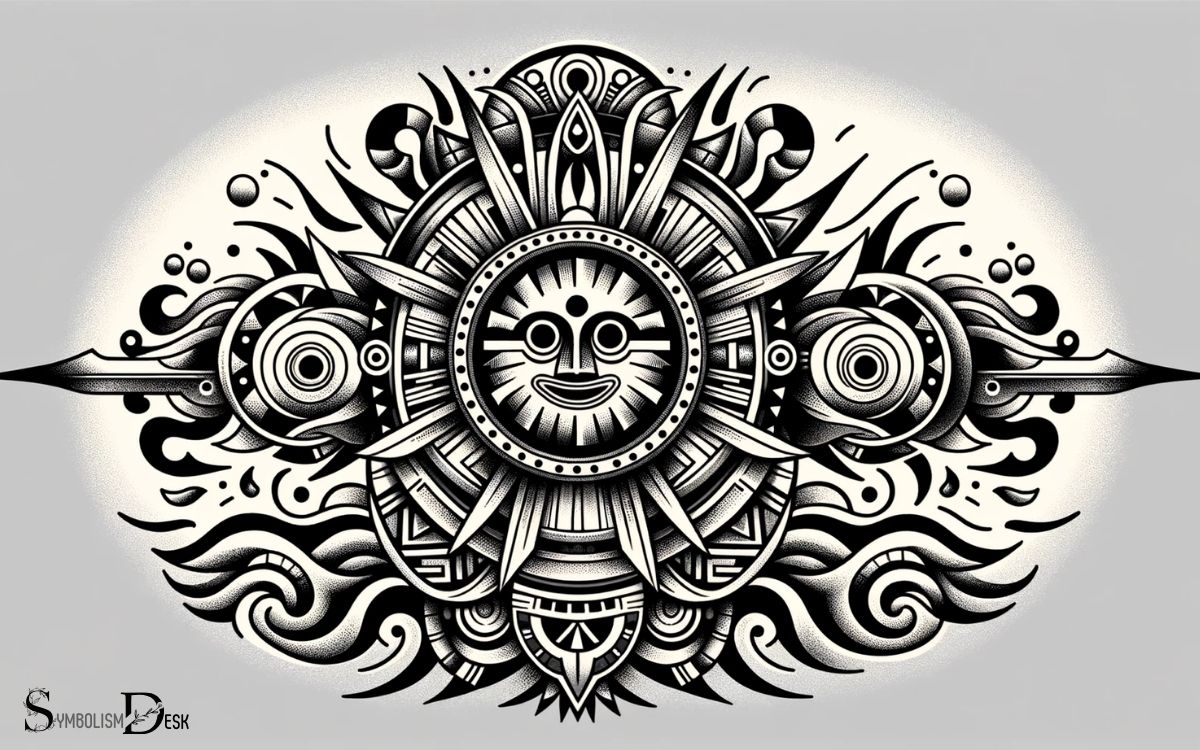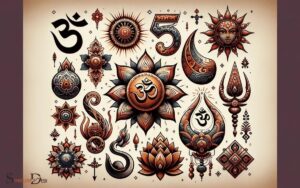Filipino Tribal Tattoo Symbols and Meanings: Beliefs!
Explore the profound realm of Filipino tribal tattoos, which are rich in history and carry deep symbolic meanings.
These tattoos are not just body art but are also a testament to the wearer’s heritage and personal journey.
Each design is a representation of the wearer’s identity, beliefs, and social status within the community.
Filipino tribal tattoos, known as ‘batek’ or ‘batok,’ have been part of the cultural fabric of the Philippines for centuries.
Traditionally, these tattoos were applied using a tapping technique with tools made from natural materials like citrus thorns and bamboo.
Here are some key points to consider:
- Spiritual Significance: Tattoos were believed to provide spiritual protection and strength.
- Symbolic Representation: Common symbols include the sun, which represents divinity and the highest honor, and the eagle or ‘sarimanok,’ symbolizing freedom and high status.
- Cultural Identity: Tattoos were a rite of passage, marking milestones and achievements in an individual’s life.
- Contemporary Revival: Today, there is a resurgence of interest in these traditional tattoos, with both Filipinos and non-Filipinos embracing these designs for their beauty and cultural significance.
Filipino tribal tattoos are a beautiful legacy, weaving the story of an individual’s heritage and personal triumphs into their skin.

Key Takeaway
The History of Filipino Tribal Tattoos
The history of Filipino tribal tattoos can be traced back to ancient times when these tattoos were an integral part of the culture and traditions of the indigenous tribes in the Philippines.
These tattoos held deep significance and weren’t just a form of body art, but also a representation of one’s identity, achievements, and status within the tribe.
Each tribe had its unique tattoo designs and techniques, often using thorns or sharp tools to create intricate patterns on the skin.
These tattoos weren’t only a means of adornment but also served as a way to connect with their spiritual beliefs and cultural heritage.
Over time, these traditional tattoo practices have influenced modern tattoo artistry, preserving the rich cultural heritage of the Filipino tribes.
Traditional Filipino Tribal Tattoo Symbols
Traditional Filipino tribal tattoo symbols hold deep cultural significance and are a reflection of the indigenous tribes’ rich heritage and spiritual beliefs.
These symbols often represent elements from nature, such as animals, plants, and celestial bodies, which are integral to the tribal communities’ way of life.
For instance, the sarimanok, a mythical bird in Maranao culture, symbolizes power and prestige. The buaya, or crocodile, is a symbol of strength and protection in Visayan culture.
Other common symbols include the sun, which represents life and energy, and the waves, symbolizing the ebb and flow of life’s challenges.
Each symbol is imbued with layers of meaning and history, serving as a visual language that connects the Filipino tribes to their ancestors and the natural world around them.
Spiritual Significance of Filipino Tribal Tattoos
Filipino tribal tattoos hold a deep spiritual significance within the culture, connecting individuals to their heritage and beliefs.
The symbolism embedded in the tribal designs reflects the values, stories, and traditions passed down through generations.
Rituals surrounding tattooing in Filipino tribes further emphasize the spiritual and cultural importance of these ancient art forms.
Cultural Connection to Spirituality
Tribal tattoo symbols in Filipino culture hold deep spiritual significance for the community. These tattoos aren’t merely decorative; they’re an integral part of the Filipino people’s spiritual beliefs and practices.
The designs are often linked to their animistic traditions, which revolve around the belief that spirits inhabit natural elements and objects.
For Filipinos, tribal tattoos serve as a way to connect with these spirits, seeking their protection, guidance, and blessings.
The act of receiving a tattoo is a sacred ritual, often performed by a respected elder or a traditional tattoo artist who also functions as a spiritual guide. The process involves invoking the spirits and infusing their power into the tattoo.
This spiritual connection is what makes Filipino tribal tattoos deeply meaningful and revered within the culture.
Understanding this spiritual significance is crucial to appreciating the symbolism in tribal designs.
Symbolism in Tribal Designs
Having a deep spiritual connection to their animistic traditions, Filipino tribal tattoo symbols hold profound significance for the community, embodying the belief in spirits inhabiting natural elements and objects.
These symbols are not merely decorative; they convey powerful meanings deeply rooted in the Filipino culture.
The following table provides a glimpse into the spiritual significance of some common Filipino tribal tattoo symbols: The following table provides a glimpse into the spiritual significance of some common Filipino tribal tattoo symbols: These intricate designs not only reflect the rich cultural heritage of the Philippines but also convey stories of bravery, protection, and connection to the divine. Much like their Filipino counterparts, Indonesian tattoo symbols explained in historical contexts reveal deeply rooted beliefs and practices that are passed down through generations. Both traditions showcase a shared reverence for nature, ancestry, and spiritual guidance.
| Symbol | Meaning |
|---|---|
| Shark | Strength, power, and protection |
| Sun | Life, leadership, and a new beginning |
| Spirals | Eternal cycle of life and nature |
These symbols serve as a visual language, communicating the values and beliefs of the Filipino people.
Each stroke and curve in the designs carries a story, connecting the wearer to their cultural heritage and spiritual roots.
Rituals and Tattooing
Ritual tattooing holds a significant spiritual role in Filipino culture, symbolizing the deep connection to animistic traditions and ancestral beliefs.
The tattooing process itself is considered a sacred ritual, often performed by a tribal elder or a shaman.
Before receiving a tattoo, individuals partake in ceremonies to honor the spirits and seek their protection.
The act of tattooing is believed to not only mark the body but also to imbue the individual with the power and wisdom of their ancestors.
Each symbol and placement carries specific meanings, reflecting the wearer’s personal journey, achievements, and spiritual connections.
The rituals surrounding Filipino tribal tattooing serve as a means of connecting with the spiritual realm, preserving cultural heritage, and acknowledging the interconnection between the physical and metaphysical worlds.
Filipino Tribal Tattoo Techniques and Tools
Tattoo artists in the Filipino tribal tradition utilize traditional hand-tapping techniques and specific tools to create intricate and meaningful designs.
The hand-tapping technique, also known as ‘batok,’ involves using a wooden stick or mallet to manually tap the inked needle into the skin. This method requires immense skill and precision, resulting in fine lines and detailed patterns.
The tools used in Filipino tribal tattooing often include thorns, bamboo sticks, and traditional ink made from natural ingredients such as soot and water.
These tools and techniques have been passed down through generations, contributing to the authenticity and cultural significance of Filipino tribal tattoos.
Understanding these traditional methods provides insight into the artistry and cultural heritage behind these designs. This understanding paves the way for exploring the evolution of Filipino tribal tattoo designs.
Evolution of Filipino Tribal Tattoo Designs
Over time, Filipino tribal tattoo designs have undergone significant evolution, reflecting shifts in cultural influences and artistic expression.
Traditional motifs such as the “linukay” (spirals), “sarimanok” (mythical bird), and “baki” (mountain spirits) continue to be popular, but contemporary artists are also incorporating modern elements and personal symbolism into their designs.
The evolution of Filipino tribal tattoos has been influenced by various factors such as globalization, the revival of indigenous cultural practices, and the fusion of traditional and modern artistic techniques.
This has resulted in a rich tapestry of tattoo designs that honor the heritage of Filipino tribal culture while also embracing new forms of creative expression.
| Traditional Motif | Contemporary Interpretation | Modern Elements Included | Personal Symbolism |
|---|---|---|---|
| Linukay (spirals) | Geometric patterns | Incorporation of technology symbols | Family lineage |
| Sarimanok (mythical bird) | Abstract representation of the bird | Fusion with other mythical creatures | Representation of freedom |
| Baki (mountain spirits) | Landscape-inspired designs | Urban elements integrated | Connection to nature and environment |
Cultural Influences on Filipino Tribal Tattoos
The cultural influences on Filipino tribal tattoos are deeply rooted in indigenous art forms, historical symbolism, and significance. These tattoos reflect the rich cultural heritage and traditional beliefs of the Filipino people.
Additionally, modern cultural reinterpretations have also contributed to the evolution of Filipino tribal tattoo designs, blending traditional motifs with contemporary influences.
Indigenous Art Forms
Incorporating traditional designs and patterns from various indigenous art forms, Filipino tribal tattoos reflect the rich cultural heritage of the Philippines.
These tattoos draw inspiration from the ancient art of the indigenous tribes, such as the geometric designs of the Kalinga tribe, the intricate patterns of the Ifugao people, and the symbolic motifs of the Visayan and Mindanao tribes.
The geometric shapes, animals, plants, and mythical creatures found in these art forms are often incorporated into Filipino tribal tattoos, each carrying its own significance and meaning.
For instance, the serpent symbolizes protection, the sun represents life and eternity, and the waves signify the continuous flow of life.
Historical Symbolism and Significance
Drawing upon the historical influences of various indigenous art forms, Filipino tribal tattoos incorporate symbols and motifs that hold deep cultural significance and historical meaning. These tattoos aren’t just designs, but they carry stories, beliefs, and values of the Filipino people.
The historical symbolism and significance of Filipino tribal tattoos are rooted in:
- Ancestral worship and connection to the spirit world
- Protection from malevolent forces and dangers
- Celebration of bravery, courage, and strength
- Recognition of social status and achievements
- Commemoration of significant life events and transitions
Understanding the historical context and cultural influences behind these symbols enriches the appreciation of Filipino tribal tattoos, reflecting the profound connection between art, history, and identity.
Modern Cultural Reinterpretations
Modern cultural influences continue to shape the evolution of Filipino tribal tattoo designs, reflecting contemporary values and societal changes.
In recent years, there’s been a resurgence of interest in traditional Filipino tattooing practices, fueled by a growing sense of cultural pride and a desire to reconnect with indigenous heritage.
This revival has been influenced by a range of factors, including the globalization of tattoo culture, increased awareness of indigenous rights, and a renewed appreciation for traditional art forms.
Furthermore, the fusion of modern tattoo techniques with traditional Filipino motifs has resulted in a unique aesthetic that appeals to a broader audience.
As a result, Filipino tribal tattoos aren’t only a symbol of cultural identity but also a reflection of the dynamic interplay between tradition and modernity in today’s society.
Contemporary Interpretations of Filipino Tribal Tattoos
Contemporary tattoo artists have reinterpreted traditional Filipino tribal designs, infusing them with modern elements to create a new wave of cultural expression.
This reinterpretation reflects a fusion of heritage and contemporary identity, resonating with individuals seeking to honor their roots while embracing modernity.
Through these contemporary interpretations, Filipino tribal tattoos continue to evolve as symbols of cultural pride and personal empowerment.
- Evokes a sense of connection to one’s heritage
- Celebrates the resilience and adaptability of Filipino culture
- Reflects the dynamic nature of identity and tradition
- Encourages a deeper appreciation for indigenous art forms
- Serves as a powerful form of self-expression and empowerment
Conclusion
Filipino tribal tattoos aren’t just mere body art, but they hold deep cultural and spiritual significance for the Filipino people.
While some may argue that traditional tattooing practices are outdated, the rich history and symbolism of Filipino tribal tattoos continue to inspire and connect people to their heritage.
Embracing these ancient traditions can foster a sense of pride, identity, and belonging, preserving the legacy of Filipino tribal tattoos for future generations.






